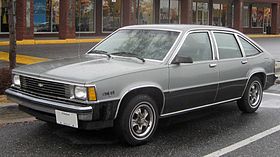GM X platform (FWD)
| GM X platform (FWD) | |
|---|---|
 |
|
| Overview | |
| Manufacturer | General Motors |
| Also called | X-body |
| Production | 1980-1985 |
| Body and chassis | |
| Class | Compact |
| Layout | Front engine, front-wheel drive |
| Body style(s) | 2-door Notchback Coupé 3-door Hatchback 4-door Notchback Sedan 5-door Hatchback |
| Vehicles |
Buick Skylark Chevrolet Citation Oldsmobile Omega Pontiac Phoenix |
| Related | GM A platform (FWD) |
| Powertrain | |
| Engine(s) |
Iron Duke I4 (gasoline) 60° V6 (gasoline) |
| Transmission(s) | 3-speed TH 125 automatic 4-speed manual |
| Dimensions | |
| Wheelbase | 104.9 in (2,664 mm) |
| Chronology | |
| Predecessor | GM X platform (RWD) |
| Successor |
GM N platform GM L platform |
The front-wheel drive X-body was used by General Motors for compact cars from 1980 to 1985. They were among the first mainstream front-wheel drive models introduced into the North American market and initially saw great sales success. They were an alternative to imported front-wheel drive sedans.
Vehicles using the X-body included:
The X platform was replaced by the L-body and N-body platforms, which were derived from the J-body platform.
However, the X-body developed a poor reputation for quality, due to engineering defects and related safety problems. Several running changes were made to the car's braking system during the first months of manufacture in 1979. Initial automobile magazine articles about the new car in the autumn of 1979 cited a dangerous tendency for the car to lock the rear wheels upon braking; then hundreds of complaints involving this behavior, including dozens of accidents, over a dozen injuries and one death triggering a lawsuit, were reported in the first year of manufacture, leading the US National Highway Traffic Safety Administration to pressure General Motors for some remedial action. Despite there being over a million of these automobiles on the road at that point, GM issued a voluntary recall of only the earliest manual transmission models, less than 50,000, declaring no safety involvement, and declining to publicize the recall. Internal documents, which eventually were leaked, revealed that GM's engineering staff were dubious that this modification to the brake proportioning valve would be sufficient, even for the cars which were subject to the recall, and that further changes to the brake linings and brake drums would be required; that would have raised the cost from $70 a vehicle to $150, in addition to greatly increasing the number of cars involved.
More complaints, accidents, injuries, and lawsuits ensued, including cars which had actually been modified according to the recall and cars from the 1981 model year, causing NHTSA to pressure GM for further action, preferably a recall of all 1.1 million vehicles in the 1980 model year for replacement of both the proportioning valves and the linings and drums. GM, however, responded in 1983 with a voluntary recall of only all manual transmission vehicles of that year and the very earliest automatic transmission cars, a total of fewer than 250,000, including those in the first recall. NHTSA responded by suing GM, demanding a recall of the entire 1980 model year, claiming the company had known as far back as 1978 of the cars' dangerous tendency to lock the rear brakes but had provided misleading and incomplete answers to NHTSA's investigation. In 1987, however, the presiding judge dismissed the suit, ruling that NHTSA had filed it prematurely and without the proper procedure of developing conclusive evidence and holding investigative hearings, relying mainly on anecdotal evidence. NHTSA had logged 4,282 complaints, including 1,417 accidents, 427 injuries and 18 fatalities.
...
Wikipedia
